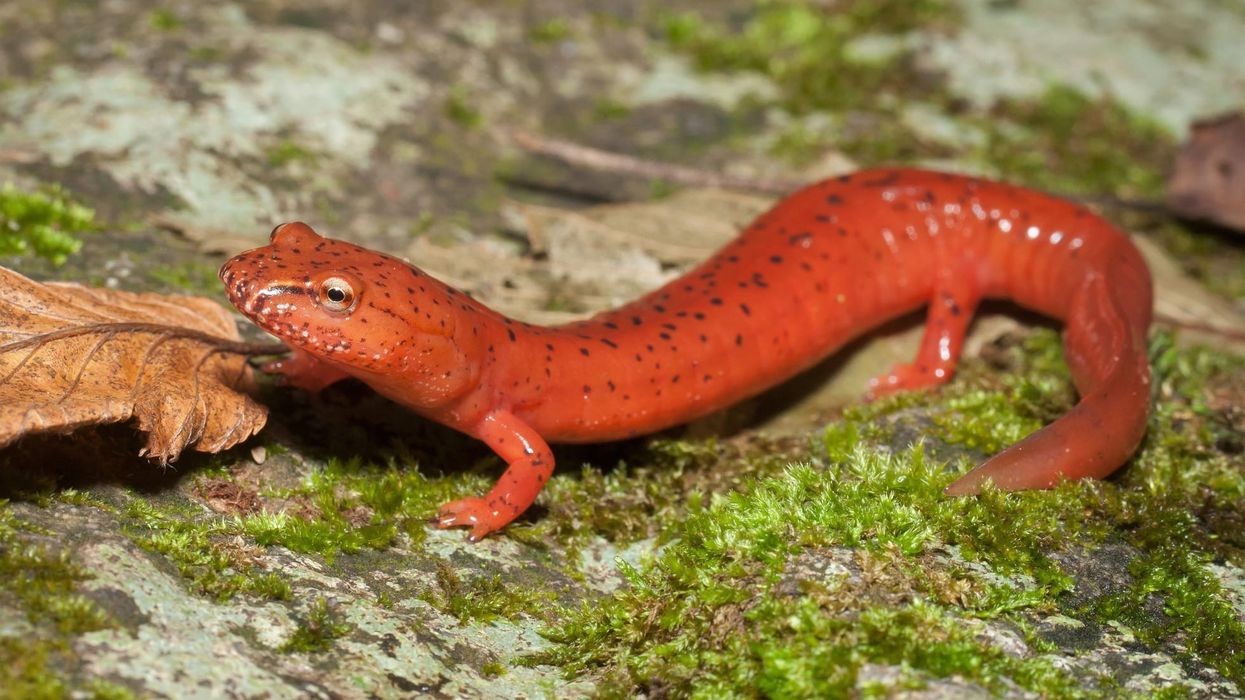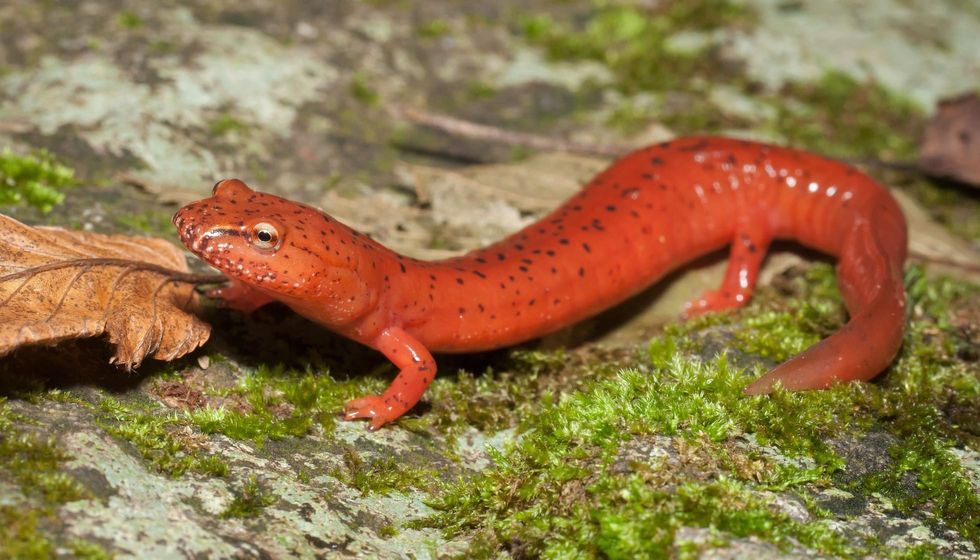No, it is not jelly. Neither is it a toy. This little animal is the spring salamander.
Popularly known as the ‘purple salamander’, the Gyrinophilus porphyriticus is a commonly spotted salamander in the United States as well as Canada. This member of the Plethodontidae family is one among the largest in the family of all lungless salamanders.
The scientific name of this species, porphyriticus, comes from Greek and Latin terms, which translates to ‘the hue of the porphyry’. Porphyry is a beautiful purple stone, and hence the name ‘purple salamander’. With these bright colors, it is just a signal for you to beware as these little creatures also secrete toxic substances.
These amphibians are primarily active after the sun sets. If there is any water around you, you will surely spot these little ones. There are four different subspecies of this spring salamanders.
Enjoying this article on the spring salamander? We are sure you will have fun reading our pages on the salamander and the tiger salamander.
Spring Salamander Interesting Facts
What type of animal is a spring salamander?
The spring salamander is a type of salamander.
What class of animal does a spring salamander belong to?
Spring salamanders fall under the class of Amphibians.
How many spring salamanders are there in the world?
Unfortunately, there is no exact estimate of the population numbers of the spring salamanders around the world.
Where does a spring salamander live?
Spring salamanders usually prefer wetlands and tropical forests.
What is a spring salamander's habitat?
As these animals are lungless, they breathe in oxygen through their skin. Thus, they prefer staying in lower altitudes where the oxygen concentration is high and there is enough moisture. Spring salamanders are found usually in habitats near fresh water.
These semi-aquatic creatures inhabit temperate forests, caves, springs, rivers, marshes, and even swamps. You might spot these salamanders resting under rocks and near logs. During winter, this species takes refuge under the stream bottoms in order to avoid being frozen.
Who do spring salamanders live with?
In general, this salmon-hued animal prefers to live on its own. They only live together with their own kind during the breeding months.
How long does a spring salamander live?
An adult of this threatened species can live up to 18 years.
How do they reproduce?
The adult female salamanders usually breed during the winter season. In the summer, the females lay anywhere between 10-100 eggs.
These eggs are usually laid in the underground stream sections, however, a few are laid in nests as well. The spring salamander larvae are mainly aquatic and stay in the larval stage for a very long time. This larval period might last up to four years.
What is their conservation status?
The conservation status of this salamander is of Least Concern.
Spring Salamander Fun Facts
What do spring salamanders look like?

Amongst all the lungless salamanders, this species holds the crown for being the largest of all. Spring salamanders have nasolabial features. Their bodies are slender and their noses are broad.
There is a small light line running down from the eye to the nostril. This light line is usually bordered by a greyish hue. Their bodies usually have a salmon pink color, but overall it varies from light brown, pink, red, and even purple.
There are also tiny flecks throughout the body which are either brown or black in color. The tails of the adults have a sharp keel which helps them swim faster underwater. Their legs are strong and thick.
How cute are they?
We find these little salamanders moderately cute.
How do they communicate?
Their bright colors are used to ward off any predators and warn them of their poisonous bodies. Preys are usually located by sight and smell. Their sign helps them detect the motion of other creatures in low light.
While mating, the salamanders communicate with each other by nudging and rubbing. In general, salamanders can communicate with each other with the help of pheromone signals. Usually, this species is considered not to communicate using sound.
How big is a spring salamander?
The salamander bodies have a body length of about 4.5-7.5 in (11.43-19 cm). However, the longest salamander ever found was about 9.125 in (23.177 cm). The salamander larvae have a body length of about 0.75 in (1.9 cm) upon hatching and can grow as long as 4 in (10.2 cm) before reaching adulthood.
This salmon-pink tinted species is a little longer than twice the length of an average shrimp.
How fast can a spring salamander move?
Unfortunately, we have found no information pertaining to this.
How much does a spring salamander weigh?
The average weight of this species is about 0.1 oz (3 g).
What are their male and female names of the species?
Surprisingly, salamanders are unisexual - all of them are females!
What would you call a baby spring salamander?
Baby salamanders are called 'efts' or 'salamander nymphs'.
What do they eat?
These amphibians munch down small invertebrates, insects, and even worms. Their diet includes crustaceans, millipedes, spiders, centipedes, snails, and frogs. However, the larger salamanders of this species would not think twice about gobbling up smaller salamanders.
Are they poisonous?
The bodies of the adult salamanders have toxic secretions from their skin, which act as a protection against dangerous predators.
Would they make a good pet?
We would not recommend keeping these amphibians as pets, as their habitats need to be taken into good consideration.
Did you know...
‘Gyrinophilus’ is the generic name for this species. This term means ‘a tadpole lover’, aptly given to this species as they spend considerably a long time as a larva before reaching their maturity.
Spring salamanders are known to breathe in with the help of their skins.
Top predators of this amphibian include water snakes and other salamanders.
The highest population densities are found mainly at the Appalachian Mountains, Georgia, Carolina, as well as other parts of Canada and northeastern regions of the United States.
Remember the little white line near the nose of the amphibian? It has got a name of its own, Canthus rostralis!
What are the different types of spring salamander?
Spring salamanders have four different subspecies.
The northern spring salamander - Gyrinophilus porphyriticus porphyriticus - these salamanders are abundantly found in New York, New England, Alabama, Ohio, North Carolina, Tennessee, Virginia, and other states of Northern USA.
The Kentucky spring salamander - Gyrinophilus porphyriticus duryi - as the name suggests, this species is native to Kentucky. They are also found in Ohio and parts of Virginia too.
The Blue ridge spring salamander - Gyrinophilus porphyriticus danielsi - this salamander is found in parts of Virginia as well as the western region of North Carolina.
The Carolina spring salamander - Gyrinophilus porphyriticus dunni - this species is found abundantly in the states of both North and South Carolina, and northern parts of Alabama and Georgia.
Why is it called spring salamander?
These animals prefer habitats close to sources of fresh water. Usually, you will find the spring salamanders living close to springs. They also are found in streams and other water bodies with water fed by springs. Hence, these salamanders have been named the ‘spring salamanders’.
Here at Kidadl, we have carefully created lots of interesting family-friendly animal facts for everyone to discover! Learn more about some other animals including the frilled lizard and the fire salamander.
You can even occupy yourself at home by drawing one of our spring salamander coloring pages.










